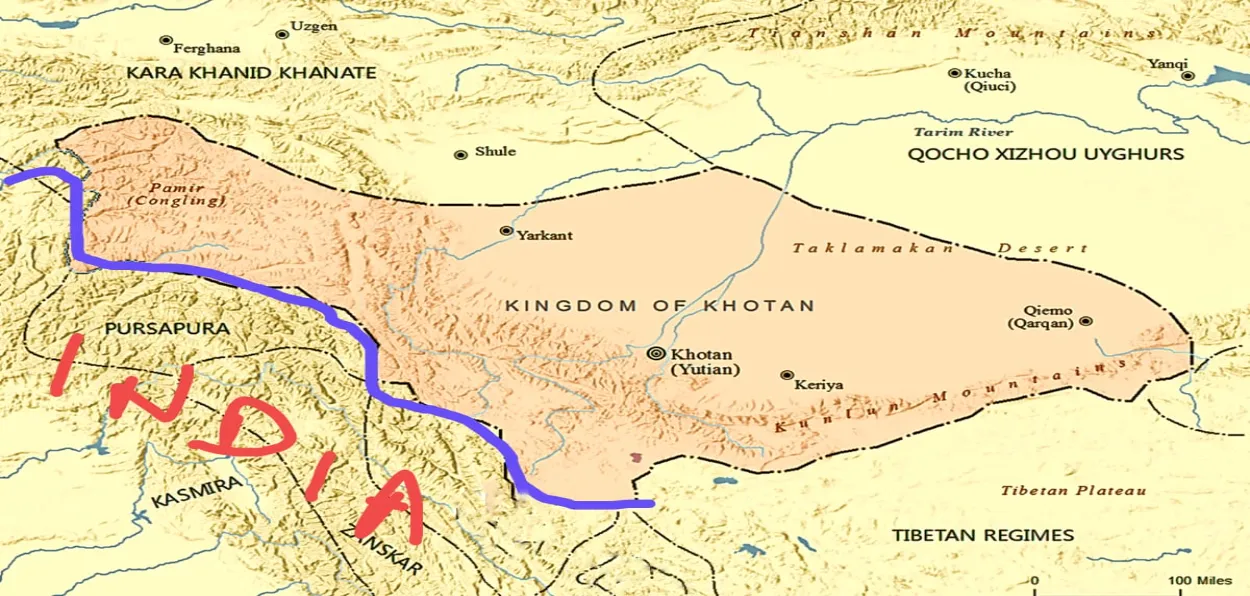
Amir Khan
Khotan, an ancient kingdom located in what is now the Hotan prefecture of China's Xinjiang region, was once an important outpost of Indian culture.This small but significant kingdom flourished for several centuries BCE and during the first millennium CE, surviving waves of migration, invasion, and domination by much more powerful states to its west and east. Khotan was known as an oasis on trans-Eurasian trade routes and was famous for its silk production and jade.
The oasis city prospered for over a thousand years before being conquered by the Muslim Kara-Khanid Khanate in 1006, leading to the Islamicisation and Turkicisation of Xinjiang.
Khotan played an important role in the spread of Buddhism from India to China, with flourishing Buddhist institutions established in the region as early as the first century BCE.
The rulers of Khotan were practitioners of Mahayana Buddhism, which blends Vedic and Tantric traditions and acknowledges deities such as Indra, Shiva, Vishnu, and Saraswati, placing the Buddha at the forefront of the spiritual hierarchy (as in Vidyakara's Treasury).
Additionally, the Khotanese people practiced Krishna worship and even had a version of the Ramayana in their native language, which was also translated into Tibetan.
The region, known as Uttarakuru in Indian texts, was an integral part of the Sanskritic world for centuries.
Its languages comprised Indian Prakrits such as Gandhari, which shares certain similarities with Kashmiri, Sanskrit, and Khotanese Saka, the latter of which has a significant amount of Sanskritic vocabulary. According to Xuanzang, a Chinese pilgrim, and Tibetan translations of Khotanese documents, Khotan was established by immigrants from northwest India during the reign of Aśoka Maurya in the 3rd century BCE. These immigrants probably included Kashmiris.
The kingdom was connected to the ancient kingdom of Gandhara and Kashmir in India's northwest and sustained Mahayana communities as early as the third century CE. The two Buddhist texts that arguably have had the greatest influence on Chinese Buddhism, The Perfection of Wisdom in Twenty-five Thousand Lines, and the Buddhavatamsaka Sutra (also known as the "Flower Ornament" Sutra), were first translated into Chinese from texts found in Khotan in the third and fifth centuries, respectively.
The kingdom's founding myths center around the draining of a lake on the orders of the Buddha Shakyamuni and describe a land planned, visited, and blessed by the Buddhas of the past. These myths are uniquely enshrined as canonical scriptures in Tibetan in the form of two sutras preserved in the Kangyur and two prophetic histories in the Tengyur. They are among some twenty texts listed by the 13th century Tibetan scholar Chomden Rikpai Raltri as having been translated into Tibetan from Khotanese.
A translation of one of these two sutras, The Prophecy on Mount Goshringa, was published recently. This sutra describes the Buddha flying to Khotan with a large entourage and blessing the creatures that live in the great lake that has hitherto filled the landscape. He consecrates the country's other features, its sacred mountain, stupas, and sites; gives teachings there; and makes prophecies about its future importance as a land for the practice and preservation of the dharma. At the end of the sutra, the Buddha asks disciple Shariputra and divine king Vaishravana to deploy their supernatural powers and drain the great lake into a river course. They cut a mountain into two great pieces and move it out of the way so that the lake can drain into a nearby river called the Gyisho, thought to be perhaps the river now known today as the Karakax.
Khotan's founding myths find a shared theme with that of another mountainous site, the Kathmandu Valley, also said to have been formed by the draining of a lake. Kashmir is also spoken of as being born out of a mountainous lake named Satisar.
The legend of Kathmandu, in which the sacred hill of Svayambhu plays a pivotal role, is recounted in the various versions of a Newar Buddhist text called the Svayambhu-Purana, an anonymous work first composed in the fifteenth or sixteenth centuries but probably based on earlier oral traditions, and developing over time into different versions of increasing length.
Despite the overlap between these stories, the destinies of the two lands could not be more different. The dharma has survived and flourished in the Kathmandu Valley, despite Nepal's many problems. But in Khotan, it has not. History has largely forgotten how important this jewel of a country once was.
ALSO READ: Modi government has brought me out of obscurity; made me famous: Padma Shri Rasheed Ahmed Quadari
By the twelfth century, little was left of Khotan's Buddhist past. The power of China had waxed and waned several times. Tibet's imperial reach had long ago collapsed. The Silk Roads had dwindled in importance.
Today Khotan remains an important landmark on the trans-Eurasian trade route that reminds us of the extent of India's cultural impact on China in not-so-very-ancient times.
